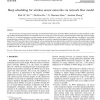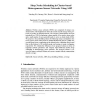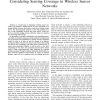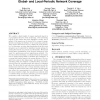21 search results - page 2 / 5 » Sleep scheduling with expected common coverage in wireless s... |
COMCOM
2006
13 years 4 months ago
2006
The pervasiveness and operational autonomy of mesh-based wireless sensor networks (WSNs) make them an ideal candidate in offering sustained monitoring functions at reasonable cost...
ICESS
2007
Springer
13 years 10 months ago
2007
Springer
Abstract. Wireless sensor networks (WSNs) are comprised of energy constrained nodes. This limitation has led to the crucial need for energy-aware protocols to produce an efficient ...
VTC
2007
IEEE
13 years 11 months ago
2007
IEEE
Abstract— A crucial issue in deploying wireless sensor networks is to perform a sensing task in an area of interest in an energy-efficient manner since sensor nodes have limited...
MOBIHOC
2009
ACM
14 years 5 months ago
2009
ACM
We consider a high density of sensors randomly placed in a geographical area for event monitoring. The monitoring regions of the sensors may have significant overlap, and a subset...
JCO
2006
13 years 4 months ago
2006
We study a novel "coverage by directional sensors" problem with tunable orientations on a set of discrete targets. We propose a Maximum Coverage with Minimum Sensors (MCM...




